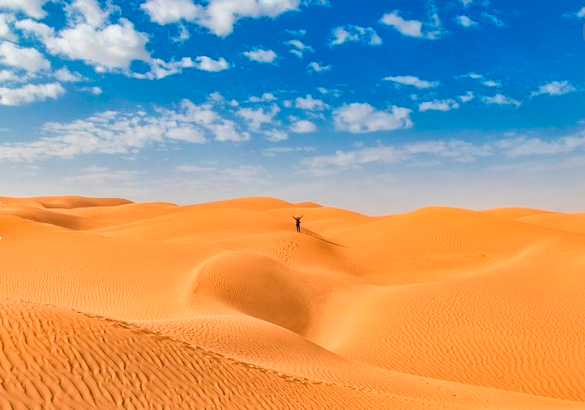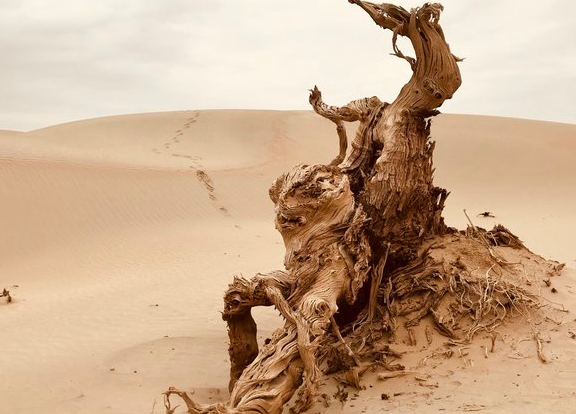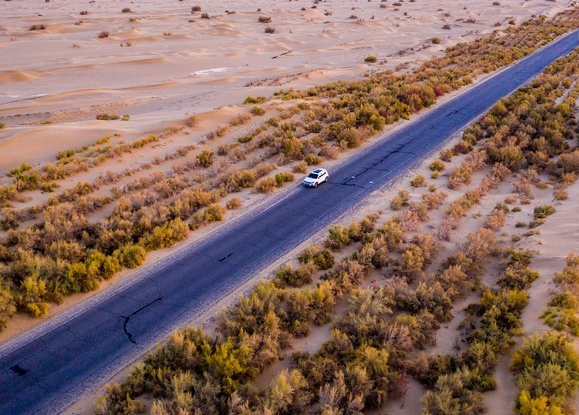24 Hours Hotline: +86 137-3541-1378
Email:[email protected]
24 Hours Hotline: +86 137-3541-1378
Email:[email protected]
Overview
The Taklamakan Desert also known as the "Place of Runis" & "Sea of Death", it is the largest desert in China with an size 1000KM long & 400KM wide. Located between the Tianshan Mounatin & Kunlun Mountain ranges. The desert is a waterless death trap,experience an average annual rainfall of just 1cm. There is an old saying goes that "It's easy to get into the Taklamakan Desert, but you will never get out". It cames from Uighur language.The historical Silk Road also passes through the desert. The desert ranks second in the world in terms of the size of shifting sand deserts. Around 85% of the desert is composed of flowing sand dunes. On a more general scale, it ranks 16th in the world in terms of area. Two routes that cross the desert, the Luntai and the Tarim Desert Highway, have been constructed by the government of the People’s Republic of China.

Mysteries and Legends
Locals recount tales that ancient cities filled with treasure lie lost and buried beneath the unknown depths of the Taklamakan Desert. In the late 1980s, an archaeological dig unearthed mummies in this remote region, some dating back to over 4,000 years. The mummies found show the wide range of peoples who have passed through the Chinese region; many exhibit Caucasoid features, and many were wearing European twill fabrics. The interest in these mummies exists largely because of their extraordinarily well-preserved state. One of the most famous mummies unearthed from the Taklamakan Desert is that of "Cherchen Man." He had reddish brown hair, a long nose, full lips and a ginger beard.The trails that border the Taklamakan Desert once formed parts of the Silk Road, the trading routes of the past that are still being used in the early 21st century.
Climate and Weather Conditions
The Taklamakan Desert has markedly extreme climate conditions; it is the driest and the warmest desert in China, yet extreme lows are recorded in wintertime. Record low temperatures of -25.7 degrees Fahrenheit were experienced during February 2008, when the desert was covered in its entirety with a thin layer of snow exceeding 1.5 inches in depth. The region in which the desert is located is completely cut off from the effects of the Asian monsoon, and Arctic storms are blocked by the encircling mountains. Because of the Taklamakan's severe lack of water, visitors are dissuaded by scientists from trying to cross this seemingly boundless desert. Most explorers venture only in winter, with teams of camels carrying ice blocks.

Habitats
Lying in the rain shadow of the Himalayas, the desert has a typical cold desert climate. Also, its close proximity to Siberia’s cold air masses make winter temperatures nearly unbearable. Therefore, plant and animal life is extremely scarce. It is extremely difficult for plants to grow since the sand is constantly shifting. The only plant life found in the desert include thin tamarisk thickets, reeds, and bushes of nitre. However, there is a bit more vegetation along the edges of the desert.
Animal life is limited to a small number of species. However, like plants, there is more diversity on the edges of the desert. On the periphery, animals such as gazelles, wild boars, foxes, and wolves can be seen. In the past, tigers also existed, but disappeared at the beginning of the 20th century. Some of the rare animals also found in the periphery include Siberian deer in the Tarim River Valley and wild camels. Other animals include rabbits, jerboas, mice, gerbils, hedgehogs, bats, and larks.

Taklimakan Desert on Ancient Silk Road
There are oases located on two routes around the desert that served as important trading spots on the Silk Road. Along the north, the route went by the Tien Shan Mountains and along the south, the Kunlun Mountains of the Tibetan Plateau. Economist André Gunder Frank, who traveled along the northern route with UNESCO, says the southern route was most used in ancient times. It joined up with the northern route at Kashgar to head into India/Pakistan, Samarkand, and Bactria.
Basic Information
Location: Tarim Basin Center,Bayu County,Xinjiang Uygur Autonomous Region
Entrance fee: Free
Opening Hours: All day
How to get there: Private transfer is the best way to visit the Taklimakan Desert
Prev: Kashgar Stone City
Wechat: Chinaprivatetour
24 Hours Hotline:
+86 137-3541-1378
* Authentic Experiences: Genuine local experiences that immerse you in the true essence of Xi'an and beyond.
* Safety First: Highest safety standards with secure activities and reliable transportation.
* Customizable Tours: Flexible itineraries tailored to your interests and needs.
* Local Expertise: In-depth knowledge of Xi'an and China, offering exclusive insights.
* Professional Guides: Licensed bilingual guides with over 5 years of experience.
* Comfortable Travel: Experienced drivers and well-maintained vehicles for a smooth journey.
* Sustainable Tourism: Commitment to responsible tourism and supporting local communities.
* Customer-Focused: Personalized service and continuous improvement based on your feedback.
* Free Cancellation: Cancel up to 24 hours before travel for flexibility and peace of mind.
* 24/7 Support: Round-the-clock assistance for any questions or help needed.
(Your Privacy is Protected)
1 to 1 tailor-made service from our professional travel advisors for the most sophisticated
Constantly excellent reviews for attraction, hotel and service Competitive price
Local experts provide quality tours Best selected knowledgeable local guides Authentic local restaurants
7*24 hours available to create you a worry-free tour. No Hidden Fees and absolutely no pressure to buy. Secured









Copyright © 2017 www.xianprivatetour.com All rights reserved. 浙ICP备18056007号-6